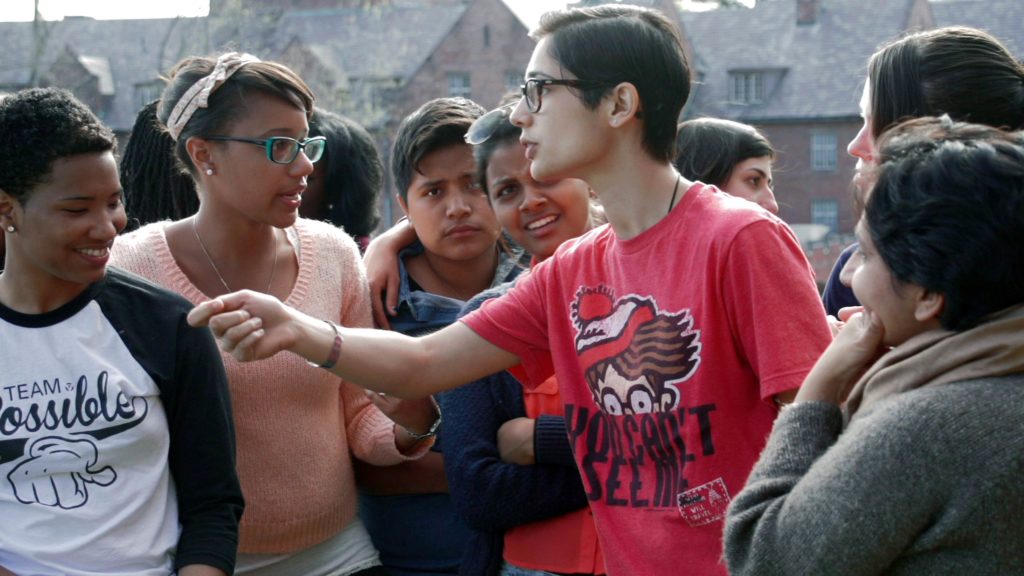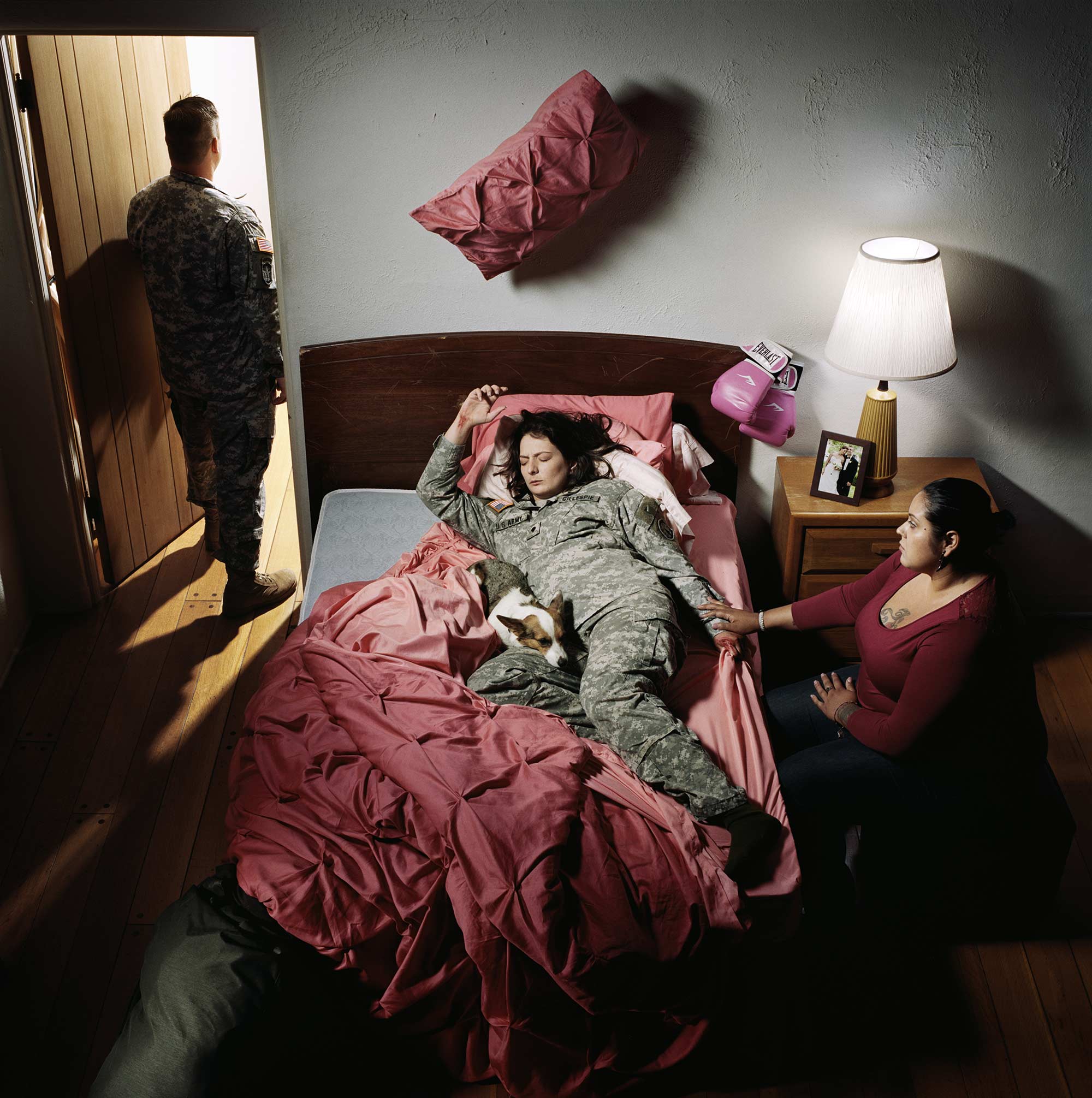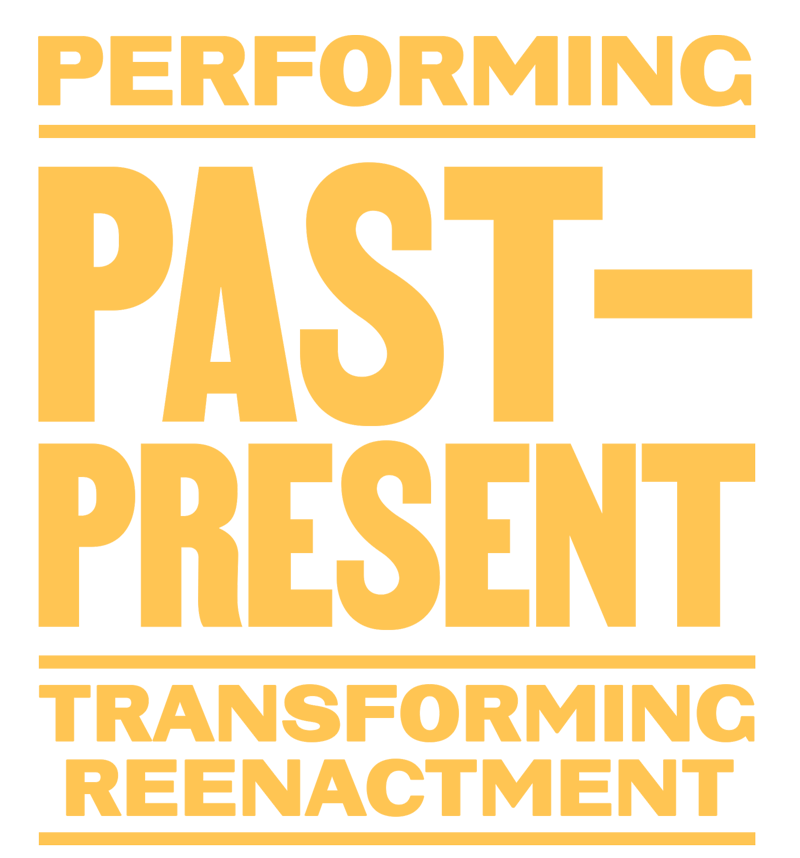Performing Past-Present: Transforming Reenactment features work by four contemporary artists who examine and represent historical issues, art, and events using conceptual, theoretical, and performance methodologies. Sharon Hayes, Jennifer Karady, Dread Scott, and Marisa Williamson bring past events into the present with performance, photography, video installations, sculpture, and material objects. Each artist uses enactment and reenactment to unsettle rigid ideas of time, space, and memory, working to reposition, personalize, and embody history in new ways.
Rooted in community, with participants as interviewees, photographic subjects, reenactors, and student researchers/artists, the works in Performing Past-Present utilize diverse social practices of engagement and collaboration. The artists spin off pivotal events and cultural moments, drawing attention to new ways of exploring and seeing temporal relationships.1
Hayes, Karady, Scott, and Williamson embrace, question, expand upon, and push against the term reenactment with descriptives that include ‘make again,’ ‘reinterpret,’ ‘remobilize,’ respeak,’ ‘retrace,’ and ‘step off,’ and by formally incorporating strategies of embodiment, citation, critical fabulation, parafiction, social practice, and community engagement.2 Their objects, embodied performances, sculptures, photographs, and installations provide nuanced ways of looking at themes on the legacy of slavery, the psychological effects of war and trauma, feminism and race, non-normative family makeup and the LGBTQ+ experience.
The works in Performing Past-Present: Transforming Reenactment bring new lenses to history and approaches to reenactment in contemporary art. They stage dialogic tension between former events and current interpretations, using the nuances of embodiment, speculative and metaphorical imaginings, and the articulation of experience. In this way, they enhance our understanding of and responses to the historical canon, politics, trauma, and identity.
MARISA WILLIAMSON
SEEDBED (2022)
Marisa Williamson works in performance, video, digital technology, and mixed-media installation to explore themes of race, history, and feminism. Underpinning her artwork are project-based performances that examine the life of Sally Hemings—a woman who was enslaved to and mother of six children with Thomas Jefferson while living unacknowledged in the shadows of his public life at Monticello. Williamson combines the few known historical certainties of Hemings’ life with speculative explorations of her interior feelings and motivations.
In my work, I attempt to make known Sally Hemings’ journey by retracing her steps and in this process, I locate a space for her in the contemporary world and space for all enslaved spirits, for they live on and are presenting the afterlife of slavery. Through Hemings, I explore how to exist as a possession and how to resist when freedom, agency, and self-possession are imminent. Hemings’ navigation of these conditions shape today’s racialized landscape. Sally herself is a ghost who walks through walls, transcending the confines and structure of time.
The Sally Hemings performances are based on the facts and details of her life, which I use strategically to create parafiction; the establishment of Hemings—a “near white” Black woman who was born into slavery—as central, destabilizes seemingly fixed power relations and acts against the historical record.3

Plinth with objects, bed, and plants.
Photo by Derrick J. Waller. Image courtesy of the artist.
Williamson embodies Hemings in live performances and videos, imagining her mundane activities on the grounds at and inside Monticello (What Would Sally Do?, 2013, The Fire (“Wild is the Wind”), 2017); placing her on a talk show in conversation with Marilyn Monroe, Monica Lewinsky, and Whoopi Goldberg (Hemings and Hawings, 2015); as a figure with a ghostlike arm based on Octavia Butler’s time-travel/speculative fiction novel Kindred (Billboard, 2019); or taking visitors on tours of the Metropolitan Museum (Sally Hemings at the Met, 2016).
Seedbed, Williamson’s mixed media installation, is a plinth made of air-dried clay that holds aloft a bed overflowing with plants. Set within the foundation are speculative objects that activate augmented reality videos made by students of “Overheard: Voices on the Underground Railroad at the Lutnick Library,” a collaboration with Williamson, while an artist in residence at Haverford, for the Visual Studies course, “Reframed: Enactment and Reenactment in Popular Culture, Digital Media, and Contemporary Art,” taught by the author/curator (Berger), Fall 2020.
Students in the class researched materials from the Haverford College Libraries Quaker & Special Collections to create new artifacts and stories based on its records of abolition and in response to Seedbed, Williamson’s ever-evolving monument to Sally Hemings. Their sources of inspiration include: autobiographies by Harriet Jacobs (Incidents in the Life of a Slave Girl) and Frederick Douglass (My Bondage and My Freedom); Wilbur H. Siebert’s The Underground Railroad from Slavery to Freedom; photographic collections of Friends Meeting Houses; photographs by James Van Der Zee, Carl Van Vechten, and Alexander Gardener; the letter books of John Greenleaf Whittier and Samuel Pennock; minutes from the Philadelphia Female Anti-Slavery Society; and pamphlets on the Free Produce Movement.4 Williamson deftly led the class through the theoretical and literary landscapes of critical fabulation, speculative fiction, and parafiction to guide their projects.5
SHARON HAYES
RICERCHE: ONE (2019)
RICERCHE: THREE (2013)
Sharon Hayes uses video, performance, sound, installation, and mixed media to interrogate particular and precise relationships between history, speech, gender/sexuality, and politics. For Symbionese Liberation Army (SLA) Screeds #13, 16, 20, & 29 (2003), her first video installation, Hayes partially memorized four audiotapes that the kidnapped Patty Hearst and the SLA sent to her family, then attempted to “respeak” them, asking the audience to cue and correct her as she spoke. In a later performance work, Hayes held up protest signs from earlier events and time periods in new situations to provoke ideas concerning political hopes and expectations (In the Near Future, 2009). The artist explains that instead of employing the term reenactment to describe her work—which often cites pre-existing texts or documents—she uses “more specific and every time a different specificity… With the Patty Hearst work…I call that a respeaking…In each case I draw these lines of specificity.”6
In 2013, Hayes released Ricerche: three, the first segment of a series (created non-chronologically) inspired by Pier Paolo Pasolini’s film, Comizi d’amore (Love Meetings, 1964. Comizi d’amore was Pasolini’s entree into cinéma vérité. Like its 1961 French progenitor, Chronicle of a Summer by Edgar Morin and Jean Rouch (about the desires of the French near the end of the Algerian War of Independence), Comizi d’amore also revolves around a central critical topic. Pasolini’s film focuses on “the sexual problem” faced by Italians during the 1960s by covering diverse themes related to sexuality such as women’s liberation, Italian machismo, prostitution, and homosexuality via a series of interviews with Italians of varying ages, generations and walks of life.


Hayes’s Ricerche series “steps off” Pasolini’s film to examine questions of sex, sexuality, and gender-based relations in the contemporary U.S.7 Ricerche: three is an interview with 35 students at Mount Holyoke on a range of topics including studying at a women’s college, patriarchy, feminism, religion, and sexuality. Ricerche: one playfully addresses a central question from Pasolini’s film: How are babies born? Hayes interviews two groups of children of LGBTQ+ families— 5-to-8-year-olds and young adults—on a Provincetown Beach during an annual gathering called Family Week. A third part of the series, Ricerche: two (2020), not shown in the exhibition, is a group interview of 23 members of two women’s tackle football teams in Dallas/Fort Worth, Texas that covers the players’ passion for football and how that shapes their ideas on family, sexuality, and gender. Hayes’s interview methods are influenced by Pasolini’s insightful film—she converses with people in groups of interest and experience, as did he, which encourages spontaneity and understanding.
Formally, Comizi d’amore’s theatrical film format is transformed in the Ricerche series as discrete, physically intimate video installations. Ricerche: one is shown on two flat screens of an A-frame that sit on the floor. Viewers watch the two screens from benches set at the level of the participants on the beach. Ricerche: three is presented on a large single screen (shown theatrically in VCAM for this show) and shot and edited to encompass the wide-ranging and free- flowing dialogue among Hayes and the students. Each part of this series-in-progress is a dynamic forum for ideas and discoveries: The completed series will be in five parts.
JENNIFER KARADY
SOLDIERS’ STORIES FROM IRAQ AND AFGHANISTAN (2006—)
Jennifer Karady is a visual artist working in photography, video, and sound installation to reveal invisible, often dark unspoken psychological truths about human nature and the human experience. She creates photographic studies that draw from a tradition of narrative photographic portraiture combined with an interpretation of psychological conflict. Karady attributes her staging methods to the history of artists like O.J. Rejlander’s allegorical photomontages, Gregory Crewdson’s other-worldly scenes of urban America, Jeff Wall’s elaborate documentary-like tableaux, and Edward Hopper’s hyper-realist paintings. Distinctively, she collaborates with real subjects to make the photographic tableaux, and uses methods that she began developing in two earlier projects: Splitting Seams (1998), an autobiographically based series of photographs that embodies mother/daughter identity formation; and Animal Project (2002–06), which elucidates the inter- relationships between human subjects and their animals.
Karady was inspired to create what has become her longest- term photographic study, Soldiers’ Stories from Iraq and Afghanistan, in the mid-2000s while following news stories of the U.S. wars in these countries. Moved by the soldiers’ psychological dilemmas, Karady sensed the therapeutic possibilities of portraits co-created with them and responded to Veteran Affairs psychiatrist and author Jonathan Shay’s call “for artists to participate in the ‘circle of communalization,’ a social process essential to the healing of individual veterans.”8

She begins by conducting in-depth interviews with veterans who wish to share a life-changing (often traumatic) moment from their time in combat; together they stage a photograph that combines that event with how its memory resurfaces in their civilian life—these moments are often triggered by an unexpected sound, movement, or visual memory. The resulting simulated photographs of collapsed time and space are captured directly on photographic film without digital manipulation and are accompanied by a text and sometimes an audio recording of the soldier’s story. The processes are meaningful to soldiers as they readjust to noncombatant life. Karady explains:
The photographs are intended to reveal something invisible, emotional, and unconscious—what it can feel like for the veteran coming home to live in two different realities at once and how the past can infiltrate the present—whether in the form of a flashback, a memory, an instinct, a dream, or an image that pops into their head… Often the precise location is chosen to convey a specific aspect of the veteran’s story metaphorically.9
To date, Karady has made twenty-one portraits with former soldiers of the Iraq and Afghanistan Wars. The three portraits for this exhibition represent a small, but meaningful selection of their individual stories; the body of work provides a larger aggregate of the soldiers’ experiences and the complex emotional consequences of war and trauma.
DREAD SCOTT
SLAVE REBELLION REENACTMENT (NOVEMBER 8–9, 2019)
Artist Dread Scott organized Slave Rebellion Reenactment (SRR) to “restage and reinterpret” the German Coast Uprising of 1811, the largest slave rebellion in the U.S., which took place along the Mississippi River Parishes and sugar plantations north of New Orleans.10 The revolt was ruthlessly defeated by regional militias and Federal troops, and the factual, historical details were long hidden from the public by leaders who were threatened by the size and success of the uprising.11
In Dred Scott vs. Sandford (1857), the artist’s namesake challenged the Supreme Court for recognition as a free man; in SRR, Dread Scott and participants enact Black resistance to a future preordained by the history of slavery.12 Using the format of a “community engaged performance,” Scott and over 350 participants, interested in and affected by the history of slavery in the U.S., walked the route of the revolt and reflected on the original goals of the insurrection, which was to achieve freedom by overthrowing the system of enslavement and establishing a new republic in Orleans Territory.

RR subtly recreates only selective details of the repressed 1811 slave rebellion for the purpose of “interrupting the historic timeline” to emphasize its emancipatory goals and vision for a new society.13 Symbolically, the reenactment ends at Congo Square, a historic Black public gathering
place in New Orleans, as reenactors sing out the names of the 1811 revolutionaries to Janelle Monae’s 2015 protest song, “Hell You Talmbout,” a chant comprised of the names of contemporary Black victims of violence.
SRR was developed as part of a set of works, including a book, the reenactment itself, exhibition performance stills, and a video installation. Fragments of the Peculiar Institution: A Project by the Artist Dread Scott (2015), provides an illustrated history of slavery leading up to the 1811 revolt. Documentary stills shot by Soul Brother express the reenactment’s temporal overlay between the colonial past and the contemporary present. Multiple aspects of the reenactment were recorded by John Akomfrah, renowned British film director and visual artist of Ghanaian descent, which will be reframed as a five- channel video installation.
Footnotes
- “The sheer numbers of twenty-first-century artists exploring reenactment as medial material, as a fertile mode of inquiry, as a means of making and as a mode of art practice, should be indicative of a turn or into temporality as a malleable substance, capable of intervention and (re)articulation.” (Rebecca Schneider, Performing Remains: Art and War in Times of Theatrical Reenactment. London and New York: Routledge, 2011, 182)
- Hayes says, “I very specifically don’t use the word reenactment because I need to make a resistance against that and from that because it doesn’t describe what I do.” (Shannon Jackson, et al, “Again, in Another Time and Space: A Conversation on Restaging, Reconstruction, and Reenactment.” Pew Center for Arts and Heritage, Philadelphia, 2014, https://vimeo.com/96117665)
- Marisa Williamson, “Seeking Sally Hemings,” In Search of African American Space: Reshaping Racism, eds. Jeffrey Hogrefe, Scott Ruff with Carrie Eastman, Ashley Simone/Lars Müller Publishers, 2020
- Student Fall 2020 course projects: Noorjehan Asim, Reimagining the Wartime Sketchbook; Margot de Abreu, To and From the Desk of John G. Whittier; Hilda Delgado, The Journey of Josephine Starks; Mingwei Gao (Sherry), Free Produce and Free Luxury; Owen Genco-Kamin, Samuel Pennock’s Letterbook; Aaliyah Joseph, untitled (I See Ghosts); Ellie Kerns, Status: Missing; Rebecca Matson, The Philadelphia Star; Isaac Wasserman, 20 Reasons; Madeline Webster, The Doll Lost in Time; Clara Zhang, Students’ Strike Chess Game
- Course readings included: Saidiya Hartman, Wayward Lives, Beautiful Experiments, New York, London: W.W. Norton and Company, 2019; Octavia Butler, Kindred, Boston: Beacon Press, 1979; Carrie Lambert-Beatty, Make Believe: Parafiction and Plausibility, October 129, Summer 2009, 51–84.
- Shannon Jackson, et al, “Again in Another Time and Space”
- “Ricerche is a 5-part video series that steps off Pier Paolo Pasolini’s brilliant 1963 film, Comizi d’Amore, to stage a contemporary inquiry into the “sexual problem” in the United States.” (Hayes) http://shaze.info
- Shay wrote: “It is impossible to overstate the importance of the arts in creating supportive social movements that permit trauma to have voice and the voice to be heard, believed, and remembered.” Chuck Mobley, “On Returning: An Interview with Jennifer Karady,” Jennifer Karady: In Country: Soldiers’ Stories from Iraq and Afghanistan, Daniell Cornell, Palm Springs: Palm Springs Art Museum, 2014, 52 – 57 (52)
- Mobley, “On Returning,” 56
- “Our reenactment restaged and reinterpreted Deslondes’ German Coast Uprising of 1811—the largest rebellion of enslaved people in United States history, which took place upriver from New Orleans. SRR animated a suppressed history of people with an audacious plan to organize, take up arms and seize Orleans territory, to fight not just for their own individual emancipation, but to end slavery. It was a project about freedom.” https://www.dreadscott.net/portfolio_page/slave-rebellion-reenactment/
- See Maria Fessenden, “How a Nearly Successful Slave Revolt Was Intentionally Lost to History,” Smithsonian Magazine, Jan. 8, 2016, https://www.smithsonianmag.com/smart-news/its- anniversary-1811-louisiana-slave- revolt-180957760/
- See Will Cameron and Dread Scott, “A conversation concerning the 1811 Slave Rebellion Reenactment,” Cameron, “Okay, you’re trying to enact awareness as an artist. You do the things the artist does to enact awareness with this group.” Saul Ostrow and Will Cameron, eds. Dread Scott, Fragments of the Peculiar Institution: A Project by the Artist Dread Scott, Critical Practices, Inc., 2015, 90 – 93 (93)
- “We are interrupting the historic timeline when we do this re-enactment,” Scott said. (Oliver Laughland, “It makes it real: hundreds march to re-enact 1811 Louisiana slave rebellion,” The Guardian, 11 Nov. 2019, https://www.theguardian.com/us-news/2019/nov/11/louisiana-slave-rebellion-reenactment-artist-dread-scott)

